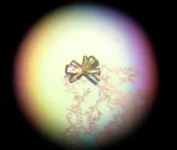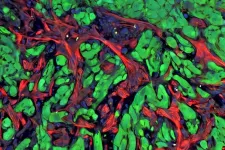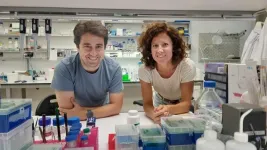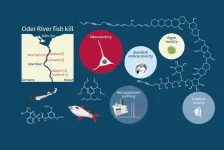(Press-News.org) Researchers have achieved data rates as high as 424Gbit/s across a 53-km turbulent free-space optical link using plasmonic modulators— devices that uses special light waves called surface plasmon polaritons to control and change optical signals. The new research lays the groundwork for high-speed optical communication links that transmit data over open air or space.
Free-space-optical communication networks could aid space exploration because they can provide high-speed, high-capacity data transmission with lower latency and less interference than traditional radio frequency communication systems. This could lead to more efficient data transfer, better connectivity and enhanced capabilities for space missions.
Laurenz Kulmer from the Leuthold group of ETH Zurich will present this research at Frontiers in Optics + Laser Science (FiO LS), which will be held 23 – 26 September 2024 at the Colorado Convention Center in Denver.
“High-speed free-space transmission is an option to connect the world, or it may serve as a backup if underwater cables break,” said Kulmer. “Nevertheless, it is also a step towards a new cheap high-speed internet that may connect all locations across the world. This way it may contribute towards a stable, high-speed internet for millions of people who are currently unconnected.”
Plasmonic modulators are ideal for space communication links because they are compact while also operating at high speeds over a wide temperature range with low energy consumption.
In free-space optical outdoor experiments, the researchers achieved information rates of up to 424 Gbit/s below a 25% SD FEC threshold — the point at which a system can still fix errors in transmitted data despite interference or noise. Experiments using a plasmonic IQ modulator in a standard fiber system achieved an even higher throughput of up to 774 Gbit/s/pol while staying below a 25% SD FEC threshold.
Based on these results, the researchers say that combining plasmonic modulators with coherent free-space optical communication could help increase overall throughput, with speeds potentially reaching 1.4 Tbit/s. The findings also show that it is favorable to operate free-space optical links at the highest speeds, rather than using higher order modulation formats and low speeds. With additional improvements in device design and photonic integration, the researchers say it should be feasible to reach polarization multiplexing data rates above 1 Tbit/s for each polarization channel.
“In a next step we are going to test the long-term reliability of our devices,” said Kulmer. “High-speed performance has been shown, but we have to make sure they can operate for years to come in the harshest of environments, space.”
About Frontiers in Optics + Laser Science
Frontiers in Optics, the annual meeting for Optica is presented with Laser Science, the annual meeting of the American Physical Society, Division of Laser Science. The two meetings unite communities from both societies for comprehensive and current research in a diverse collection of optics and photonics topics and across the disciplines of physics, biology and chemistry. The 2024 FiO LS Conference will feature hundreds of live contributed and invited talks. More information at https://www.frontiersinoptics.com.
About Optica
Optica, Advancing Optics and Photonics Worldwide, is the society dedicated to promoting the generation, application, archiving and dissemination of knowledge in the field. Founded in 1916, it is the leading organization for scientists, engineers, business professionals, students and others interested in the science of light. Optica's renowned publications, meetings, online resources and in-person activities fuel discoveries, shape real-life applications and accelerate scientific, technical and educational achievement. Discover more at: Optica.org
END
Plasmonic modulators could enable high-capacity space communication
High-speed free-space data transmission could improve connectivity for space missions
2024-09-06
ELSE PRESS RELEASES FROM THIS DATE:
UPenn’s Orphan Disease Center to amplify SYNGAP1 research: SynGAP Research Fund’s Million Dollar Bike Ride team raises $74,851 for one-year grant
2024-09-06
Mill Valley, CA – September 5, 2024 – The SynGAP Research Fund 501(c)(3) is proud to announce its continued collaboration with the University of Pennsylvania’s (UPenn) Orphan Disease Center (ODC) through the Million Dollar Bike Ride (MDBR) Pilot Grant Program. ODC is accepting proposals for a grant award of $74,851 to further advance critical research in SYNGAP1-Related Disorders (SRD). Instructions for submitting a letter of interest are available here. Applications are due in two weeks by September 20, 2024.
Why We Participate in This Project
The SynGAP Research ...
Crystallized alternative DNA structure sheds light on insulin and diabetes
2024-09-06
The first crystal structure of an alternative DNA shape from the insulin gene has been revealed by a UCL-led research team.
DNA is widely accepted to be formed of two strands that wind around one another, known as a double helix, but it is possible for DNA to change shape and structure. The new study, published in Nature Communications, reveals the detail in the structure of a type of DNA called i-motif by crystallising it for the first time.
Co-lead author Dr Zoë Waller (UCL School of Pharmacy) ...
Protecting just 0.7% of world’s land could help save a third of most unique and endangered species
2024-09-06
Conservation efforts directed towards just 0.7% of the world’s land mass could help protect one third of the world’s threatened and unique tetrapod (four-limbed vertebrate) species, new research by Imperial College London, On the Edge, and ZSL has shown.
The study, led by researchers at Imperial College London and published this week in Nature Communications, finds that large gains in conservation are possible by focusing on areas home to exceptional biodiversity and species with high levels of evolutionary distinctiveness and global ...
TGF-beta and RAS signaling are both required for lung cancer metastasis, study finds
2024-09-06
When it comes to cancer metastasis, it takes two to tango. That was one of the key findings of a new study led by researchers at Memorial Sloan Kettering Cancer Center (MSK): The TGF-beta and RAS signaling pathways work together to spur the spread of cancer in lung adenocarcinoma, a leading cause of cancer deaths around the world.
Take away one of those two signals, and lung cancer will not be able to spread (metastasize) to new parts of the body, their findings in animal models suggest.
The research, published September 6 in Cell, points to new opportunities to potentially prevent metastasis, thanks to an updated understanding of the underlying processes.
“About ...
5 lessons to level up conservation successfully
2024-09-06
Conservation needs to scale successfully to protect nature. A new paper takes lessons from around the world to show how that might be done.
To reverse biodiversity loss and meet ambitious global targets, conservation programmes designed to preserve everything from forests to fish need to work ‘at scale’.
Scaling can mean three things. Scaling ‘out’ means expanding a programme to new people and places, while scaling ‘up’ means bringing in higher-level institutions, such as governments introducing policies or incentives that make it easier for individuals and private companies to engage.
Scaling ‘deep’ means changing hearts and minds – ...
Researchers advance new class of quantum critical metal that could advance electronic devices
2024-09-06
A new study led by Rice University’s Qimiao Si has unveiled a new class of quantum critical metal, shedding light on the intricate interactions of electrons within quantum materials. Published in Physical Review Letters on Sept. 6, the research explores the effects of Kondo coupling and chiral spin liquids within specific lattice structures.
“The insights gained from this discovery could lead to the development of electronic devices with extreme sensitivity, driven by the unique properties of quantum-critical ...
DOE, ORNL announce opportunity to define the future of high-performance computing
2024-09-06
The U.S. Department of Energy’s (DOE) Office of Science (SC) today announced a new research and development opportunity led by Oak Ridge National Laboratory (ORNL) to advance technologies and drive new capabilities for future supercomputers. This industry research program worth $23 million, called New Frontiers, will initiate partnerships with multiple companies to accelerate the R&D of critical technologies with renewed emphasis on energy efficiency for the next generation of post-exascale computing in the 2029 ...
Cannabidiol demonstrated to alleviate symptoms of Leigh syndrome
2024-09-06
A study led by the UAB Institut de Neurociències and published in the journal Nature Communications demonstrates in animal models how daily administration of cannabidiol (CBD), a substance obtained from the cannabis plant, extends lifespan and improves symptoms associated with Leigh syndrome. This severe mitochondrial disease affecting children is characterised by a progressive decline in cognitive and motor functions and premature death. The research group also demonstrated in both mice and fibroblasts from children with ...
A chemical cocktail of micropollutants amplified the effect of algal toxins causing mass fish mortality on the River Oder in 2022
2024-09-06
Summer 2022’s environmental disaster led to the death of up to 60 per cent of fish biomass and up to 85 per cent of mussel and snail biomass in the River Oder. In August 2022, the UFZ set up an interdisciplinary ad hoc working group together with researchers from the Leibniz Institute of Freshwater Ecology and Inland Fisheries (IGB), the University of Veterinary Medicine, Vienna (Vetmeduni) and the University of Birmingham. They took water samples at five locations along the Oder, extracted poisoned ...
Generative AI in cancer imaging: revolutionizing detection & diagnosis
2024-09-06
“This editorial explores its impact on expanding datasets, improving image quality, and enabling predictive oncology.”
BUFFALO, NY- September 6, 2024 – A new editorial was published in Oncotarget's Volume 15 on September 4, 2024, entitled, “Generative AI in oncological imaging: Revolutionizing cancer detection and diagnosis.”
Generative AI is revolutionizing oncological imaging, enhancing cancer detection and diagnosis. This editorial explores its impact on expanding ...
LAST 30 PRESS RELEASES:
Numbers in our sights affect how we perceive space
SIMJ announces global collaborative book project in commemoration of its 75th anniversary
Air pollution exposure and birth weight
Obstructive sleep apnea risk and mental health conditions among older adults
How talking slows eye movements behind the wheel
The Ceramic Society of Japan’s Oxoate Ceramics Research Association launches new international book project
Heart-brain connection: international study reveals the role of the vagus nerve in keeping the heart young
Researchers identify Rb1 as a predictive biomarker for a new therapeutic strategy in some breast cancers
Survey reveals ethical gaps slowing AI adoption in pediatric surgery
Stimulant ADHD medications work differently than thought
AI overestimates how smart people are, according to HSE economists
HSE researchers create genome-wide map of quadruplexes
Scientists boost cell "powerhouses" to burn more calories
Automatic label checking: The missing step in making reliable medical AI
Low daily alcohol intake linked to 50% heightened mouth cancer risk in India
American Meteorological Society announces Rick Spinrad as 2026 President-Elect
Biomass-based carbon capture spotlighted in newly released global climate webinar recording
Illuminating invisible nano pollutants: advanced bioimaging tracks the full journey of emerging nanoscale contaminants in living systems
How does age affect recovery from spinal cord injury?
Novel AI tool offers prognosis for patients with head and neck cancer
Fathers’ microplastic exposure tied to their children’s metabolic problems
Research validates laboratory model for studying high-grade serous ovarian cancer
SIR 2026 delivers transformative breakthroughs in minimally invasive medicine to improve patient care
Stem Cell Reports most downloaded papers of 2025 highlight the breadth and impact of stem cell research
Oxford-led study estimates NHS spends around 3% of its primary and secondary care budget on the health impacts of heat and cold in England
A researcher’s long quest leads to a smart composite breakthrough
Urban wild bees act as “microbial sensors” of city health.
New study finds where you live affects recovery after a hip fracture
Forecasting the impact of fully automated vehicle adoption on US road traffic injuries
Alcohol-related hospitalizations from 2016 to 2022
[Press-News.org] Plasmonic modulators could enable high-capacity space communicationHigh-speed free-space data transmission could improve connectivity for space missions










